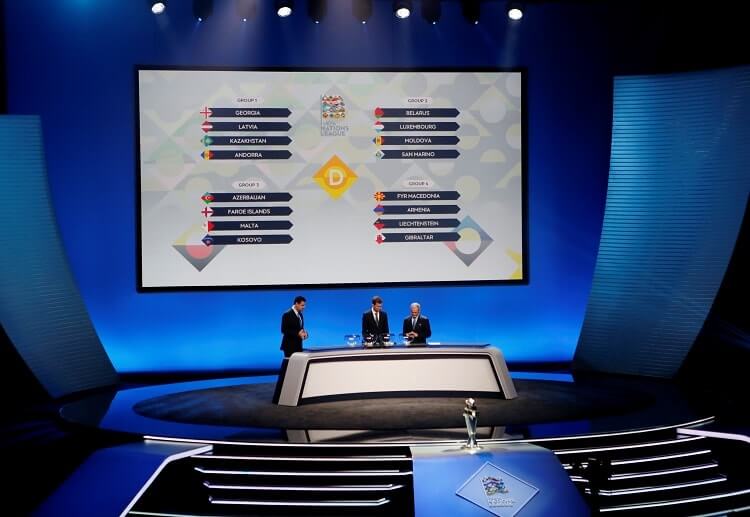The inaugural edition of the UEFA Nations League is set to kick off this September and SBOBET is here to provide you with a simplified guide to the ins and outs of the new European national team competition.
UEFA and its member associations have long desired for real competitive football to replace what they deem as “meaningless” international friendlies. And after more than seven years of extensive discussions and planning, the European football governing body has created the Nations League—a humongous tournament that features a top level with promotion and relegation, and one that offers a route to the European Championships.
While it basically looks like the usual European top-flight league, it’s a little bit more complicated given the groupings and the path teams can qualify for the Euros.
The UEFA Nations League can certainly cause confusion to the casual football observer; but with more than a week left before the contest kicks off, there’s still plenty of time for you to familiarise yourself with all the necessary information about it.
Competition Format
Basics
- 55 members
- Four leagues (League A, B, C and D) with four groups each
- League A (12 Teams); League B (12 Teams); League C (15 Teams); League C (16 Teams)
- Home and away games
- League A group winners move on to final four to compete for Nations League trophy
- League B, C, D group winners are promoted
- League A, B, C bottom finishers are relegated
All 55 member associations of UEFA are part of the tournament. They are split into four leagues—League A, B, C and D—according to their position in the UEFA National Team Coefficient Rankings.
The top 12 teams form part of League A, while nations ranked 13th to 24th are in League B. The next best 15 teams are in League C and finally, the 16 lowest-ranked teams comprise League D. All the nations will be playing in a home-and-away format.
League A is what you can say as the top division. The league is divided into four groups of three teams each, with the winner of each group progressing to the final round to contest the Nations League championship.
The final round has two semi-finals, a third-place match and the final.
League B also have four groups of three teams each, while League C has one group with three teams and three groups with four teams. League D has four groups with four teams each.
The top finishers of each group in League B, C and D will gain promotion to the leagues above them. On the other hand, the bottom teams in each group of League A, B and C will be relegated to the lower leagues.
Qualification for European Championship
Basics
- European Championship final: 24 teams qualify (20 from the qualifying group stage, 4 from the play-off)
- The 16 group winners from the UEFA Nations League (4 from each league) earn a spot in the European Qualifiers play-off
- If a group winner has already qualified, it’s place in the play-off will go to the next best-ranked team in the league
- Each league has a play-off path designated. The play-off competition format features two single-leg semi-finals and one final
While the competition format is pretty straightforward, it is the rules on European qualifications where things get a little complicated. The UEFA Nations League offers a path to the Euros, with the four group winners from each league—or a total of 16 teams—earning a spot to the European Qualifiers play-offs.
The qualifying campaign for the Euros remains the same. The 55 teams will be divided into 10 groups, and the top two teams from each directly qualify to the final tournament.
Now here’s where the Nations League comes in. The remaining four places in the Euros will be awarded to the play-off winners—which, as mentioned, will be contested by the 16 group winners from League A, B, C and D.
If a group winner has already qualified to the Euros, their place in the play-off round will be given to the next best-ranked team in their league and so on.
In the European qualifiers play-offs, there will be four different play-off paths for each league. According to UEFA, the league members who qualified for the play-off will play against each other in a competition that consists of two single-leg semifinals and one single-leg final.
With this format, even the lower-league teams have a chance to make it to the European Championship final.
Teams and Groups
World Cup winners France and surprise semi-finalists Croatia are both part of League A alongside world football powerhouse teams Germany, Portugal, Belgium, Spain and England.
Interestingly, the Three Lions are in the same group as Croatia and Spain—easily the group of death of the competition. The Germans, 2014 World Cup winners, are grouped with the Frenchmen, though.
Russia and Wales headline League B, but their division is also oozing with quality with the likes of Northern Ireland, Republic of Ireland, Sweden and Denmark also vying for promotion to the top tier competition.
In League C, Slovenia are the highest-ranked nation at 25th. However, they are not the only ones capable of making the UEFA Nations League 2018 news, with the likes of Serbia, Greece and Scotland also present.
Finally in League D, the likes of Latvia, Azerbaijan, Belarus, Armenia and Luxembourg are among the 16 teams that are set to fight for the right to climb up the competition ladder.
Here’s the full breakdown of the groupings per league:
Who is playing who in the UEFA #NationsLeague?
Check out the complete breakdown of the groupings per league here ⬇ pic.twitter.com/Op67NCrxoW
— SBOBET (@SBOBET) August 29, 2018
Key Fixtures to Watch
Well, here’s the real treat for fans. While the Nations League is new, it promises plenty of exciting games that is surely way better than an international friendly.
League A is the one to watch, thanks to the format that paves the way for Europe’s top teams to play against each other. However, you shouldn’t sleep on League B as it has some interesting matches as well.
Here are five key fixtures in the UEFA Nations League that you should mark on your calendar:
Germany vs France
It’s a battle between recent World Cup winners. Germany dropped to 14th in the FIFA rankings after their poor showing in Russia, so they will certainly look to gain some respectability when they play the new World No.1. The two will meet first at the Allianz Arena on Matchday 1 on September 7, with the return fixture slated on October 17 at Stade de France.
Croatia vs England
Here’s a repeat of the recent World Cup 2018 semi-finals! England have established themselves as true contenders under Gareth Southgate, but they still have some unfinished business against the Croats who sent them packing from the grandest stage of all.
Netherlands vs Germany
The rivalry between the two nations is pretty much known all around the globe, so it’s no wonder why their meeting is one of the most highly anticipated matches of the tournament. The traditional rivals will play on Matchday 3 (October 14) and Matchday 6 (November 20).
Wales vs Republic of Ireland
Both these teams have a point to prove after missing the recent World Cup and the Nations League—against the best of the best in Europe—is undoubtedly the best place for them to make their mark. They play the opener of League B on September 7 and will rematch on October 17.
Russia vs Sweden
Russia are one of the biggest surprises of the World Cup, reaching the quarter-finals before falling to Croatia via a penalty shoot-out. Sweden, like the Russians, impressed as well and defied expectations with their last eight berth. Now, they are set to test their mettle against each other in a quest to rise up from League B. Russia host the Swedes on Matchday 3 (October 12) before taking the trip to Friends Arena on November 21.
Betting Odds
While France might be easy picks to win considering their recent success, the UEFA Nations League 2018 betting odds actually favour Spain to win at 4.30. Germany are second at 5.00 while Les Bleus are not too far behind at 5.00.
On the other hand, Netherlands (8.80), Iceland (8.60), Poland (4.50) and Croatia (5.80) are tipped to have the least chance of winning their groups, thus expected to be relegated to League B.
Russia and Sweden are expected to have a tight battle for the top spot in their group, with SBOBET odds giving them equal chance at 2.60.
Other League B sides Bosnia and Herzegovina, Ukraine and Denmark are all favoured to be promoted to League A.
League C teams Scotland, Greece, Serbia and Norway are tipped to climb up the ladder as well, while League D contenders Georgia, Belarus, Azerbaijan and FYR Macedonia are well poised to get out of the bottom division.
Disclaimer: Odds are correct at time of publish.
●●●
CHECK OUT OUR BLOG FOR MORE FOOTBALL STORIES & ODDS
Stay updated with everything sports and betting.
Follow us on social Facebook, Twitter, Instagram and YouTube.










